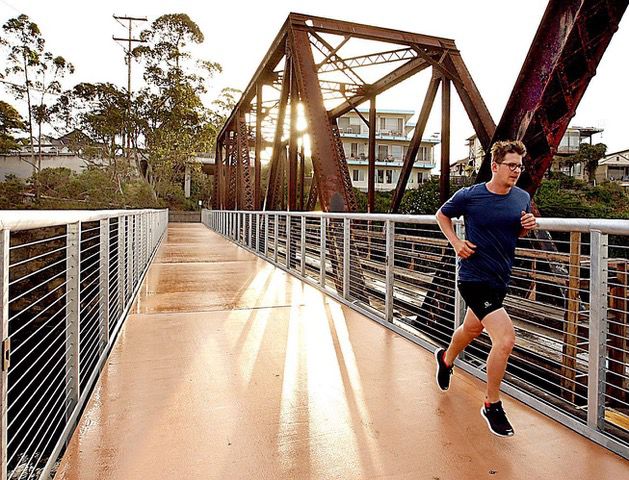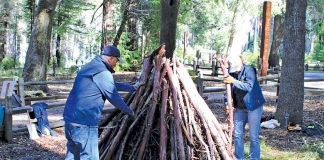Santa Cruz County’s Friends of the Rail and Trail is accomplishing big feats this week! A large segment (Segment 7, connecting Natural Bridges Drive to Beach Street) will begin constructing with a bang this Saturday, January 25th. You can attend the event with a live old-time string band, snacks, and valet bike parking from 1-3 pm at 402 Ingalls Street. I caught up with the lively and optimistic Sally Arnold, Friends of the Rail and Trail Board Chair, to hear more about FORT’s progress.
We dove right into Arnold’s vision for Santa Cruz, “The Monterey Bay Scenic Sanctuary Trail is a network of trails, and our rail trail is the backbone of it, but there’s a bunch of spur trails that connect to it… Santa Cruz has developed and grown right along the tracks so much, a big proportion of our population and our schools, businesses and our parks are all within a mile of our tracks, because our tracks were here first. We have a master plan involving all of the spur trails, and it has been approved by all the various jurisdictions: the counties, the cities, and the Coastal Commission… Imagine a network of trails that lead to the rail. You can take your bike, wheelchair, or stroller on this flat, safe, car-free space, until you get to the station.” While this level of transportation will only be accessible in our brains for quite some time, “a straight shot from downtown businesses to Wilder Ranch, without having to get involved with traffic,” will soon be ready.
Since 2002, FORT has been advocating to create public transportation and a walking trail along 32 miles of Santa Cruz County coastline, from Watsonville to Davenport. Currently only one section of the trail has been built, over the San Lorenzo River Trestle near the Boardwalk. While it’s easy to understand FORT as a singular project to update Santa Cruz public transportation, it’s much more complicated. Arnold broke it down further, “There’s two twin paths, part of an integrated system, one is the trail and the other is the rail. The trail has been divided into segments, numbered 1-20, north to south.” Arnold then described the planning processes that are occurring now at many segments, “There’s a designing phase, and engineering phase, and an environmental stage.”
A running rail system will come a bit farther down the line (pun intended). While the rail is already laid, it needs more maintenance before use. Additionally, before the rail can be used, the RTC needs to pick a type of high capacity transit, including buses and many modern rail vehicles. Arnold laughed, “We’re trying to discipline ourselves to not say ‘train’ because train makes people think of a 19th century locomotive and we’re talking about much lighter vehicles now.” The RTC and METRO will be presenting several possible transit alternatives in the middle of February, including a trial run of a possible vehicle from Capitola to the Boardwalk. Arnold made a great argument for a rail vehicle instead of buses, citing the Unified Corridor Investment Study. She pointed out many advantages to rail transportation, like major grant money, quicker commute times, lower costs, and higher carrying capacities than buses.
While this massive undertaking seems like quite an expensive venture for Santa Cruz County, Arnold easily pointed out the Rail and Trail funds. Measure D, the Santa Cruz County transportation tax, pays for the planning stages, but the physical construction can be paid through state and federal grants. “Another complicated piece is Caltrans… They have billions of dollars to give to local municipalities that want to establish passenger rail service… We are all paying taxes into this state rail fund, so we might as well get some back. It’s no longer a question of ‘I don’t want to pay my taxes for rail.’ You already are.”
When I asked Arnold about her motivation, she animatedly spoke of conserving our environment. “There’s a lot of pandering going on about climate change, and I always hear, ‘I can’t do anything about it. It’s those big oil companies.’ Well, this is something we can do locally, to make a dent in half of our carbon emissions… If we provide quality bike infrastructure, more people will get out of their cars and onto their bikes. It’s one thing to wag your finger at someone and tell them to get out of their car, but if you’re not providing a viable alternative, it’s not reasonable or fair.”
Looking past the January 25th event, many more groundbreakings are scheduled. The next segment will probably be Segment 18 in Watsonville, “a key point in connecting spur trails”. Arnold hopes for community support and feedback, “If the elected see that there’s a big enthusiasm in one direction, they’re going to act more quickly, with a lot more confidence. That’s why we really want people to come to these public meetings and show that we’re supporting it… Our next message for the community: Let’s pick a really excellent rail vehicle.” Arnold’s final words on the Rail and Trail rang optimistically and greatly inspired me, “It’s a legacy project. It’s not something we’re working on for ourselves, but for the next generation… When you’re dreaming big, real change takes real time.”
For more information on the Friends of the Rail and Trail visit https://santacruztrail.org/railtrail/. If you’d like more information on the RTC and METRO public meetings to decide on a transit vehicle, please visit https://sccrtc.org/projects/multi-modal/transitcorridoraa/. You can view the Unified Corridor Investment Study at https://www.sccrtc.org/wp-content/uploads/2019/01/UCS-Final-January2019.pdf.











